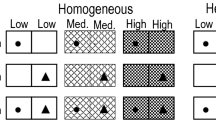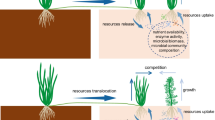Abstract
Background and aims
Intraspecific aggregation of plant individuals can promote species coexistence by delaying competitive exclusions. However, such impacts may differ among species with contrasting spatial architecture and rely on the spatial distribution of resources.
Methods
We grew a phalanx clonal plant Carex neurocarpa (with aggregated ramets) and a guerilla one Bolboschoenus planiculmis (with diffused ramets) in monocultures or in 1:1 mixtures with an even or a clustered distribution pattern of the two species in homogeneous or heterogeneous soils.
Results
After 16 months, shoot biomass and ramet number were greater in mixtures than in monocultures in C. neurocarpa, but smaller in B. planiculmis. However, the growth of neither C. neurocarpa nor B. planiculmis differed between even and clustered mixtures. Soil nutrient heterogeneity did not significantly affect the growth of either species, but increased relative yield of B. planiculmis and decreased that of C. neurocarpa.
Conclusions
The relative importance of intra- vs. interspecific competition depends on the spatial architecture of plants, and soil nutrient heterogeneity slows down competitive exclusion by decreasing differences in competitive ability between plants. However, our results do not support the idea that intraspecific aggregation of individuals alters competitive interactions between species.




Similar content being viewed by others
References
Alpert P (1991) Nitrogen sharing among ramets increases clonal growth in Fragaria chiloensis. Ecology 72:69–80
Alpert P, Mooney HA (1996) Resource heterogeneity generated by shrubs and topography on coastal sand dunes. Plant Ecol 122:83–93
Benot ML, Bittebiere AK, Ernoult A, Clement B, Mony C (2013) Fine-scale spatial patterns in grassland communities depend on species clonal dispersal ability and interactions with neighbours. J Ecol 101:626–636
Birch CPD, Hutchings MJ (1994) Exploitation of patchily distributed soil resources by the clonal herb Glechoma hederacea. J Ecol 82:653–664
Bolker BM, Pacala SW (1999) Spatial moment equations for plant competition: understanding spatial strategies and the advantages of short dispersal. Am Nat 153:575–602
Bolker BM, Pacala SW, Neuhauser C (2003) Spatial dynamics in model plant communities: what do we really know? Am Nat 162:135–148
Cahill JF, McNickle GG (2011) The behavioral ecology of nutrient foraging by plants. Annu Rev Ecol Evol Syt 42:289–311
Chen J-R, Z-Y W, Raven PH (1999) Flora of China. Science Press, Beijing
Damgaard C (2010) Intraspecific aggregation does not increase species richness in dune grasslands. J Ecol 98:1141–1146
Day KJ, John EA, Hutchings MJ (2003) The effects of spatially heterogeneous nutrient supply on yield, intensity of competition and root placement patterns in Briza media and Festuca ovina. Funct Ecol 17:454–463
de Kroon H, Schieving F (1990) Resource partitioning in relation to clonal growth strategy. In: van Groenendael J, de Kroon H (eds) Clonal growth in plants: regulation and function. SPB academic publishing, The Hague, pp 113–130
Derner J, Briske D (2001) Below-ground carbon and nitrogen accumulation in perennial grasses: a comparison of caespitose and rhizomatous growth forms. Plant Soil 237:117–127
Dong B-C, Wang J-Z, Liu R-H, Zhang M-X, Luo F-L, Yu F-H (2015) Soil heterogeneity affects ramet placement of Hydrocotyle vulgaris. J Plant Ecol 8:91–100
Fransen B, de Kroon H, Berendse F (2001) Soil nutrient heterogeneity alters competition between two perennial grass species. Ecology 82:2534–2546
Greig-Smith P (1979) Pattern in vegetation. J Ecol 67:755–779
Hart SP, Marshall DJ (2009) Spatial arrangement affects population dynamics and competition independent of community composition. Ecology 90:1485–1491
Hartnett DC, Wilson GW (1999) Mycorrhizae influence plant community structure and diversity in tallgrass prairie. Ecology 80:1187–1195
Herben T, Hara T (2003) Spatial pattern formation in plant communities. In: Sekimura T, Noji S, Ueno N, Maini PK (eds) Morphogenesis and pattern formation in biological systems-experiments and models. Springer Verlag, Berlin
Houseman GR (2014) Aggregated seed arrival alters plant diversity in grassland communities. J Plant Ecol 7:51–58
Humphrey LD, Pyke D (1998) Demographic and growth responses of a guerrilla and a phalanx perennial grass in competitive mixtures. J Ecol 86:854–865
Hutchings MJ, John EA, Wijesinghe DK (2003) Toward understanding the consequences of soil heterogeneity for plant populations and communities. Ecology 84:2322–2334
Ikegami M, Whigham D, Werger MA (2009) Ramet phenology and clonal architectures of the clonal sedge Schoenoplectus americanus (Pers.) Volk. Ex Schinz and R. Keller. Plant Ecol 200:287–301
Lamošová T, Doležal J, Lanta V, Lepš J (2010) Spatial pattern affects diversity-productivity relationships in experimental meadow communities. Acta Oecol 36:325–332
Lara-Romero C, Cruz M, Escribano-Ávila G, García-Fernández A, Iriondo JM (2016) What causes conspecific plant aggregation? Disentangling the role of dispersal, habitat heterogeneity and plant-plant interactions. Oikos 125:1304–1313
Lenssen JPM, Hershock C, Speek T, During HJ, de Kroon H (2005) Experimental ramet aggregation in the clonal plant Agrostis stolonifera reduces its competitive ability. Ecology 86:1358–1365
Liao J, Tao M, Jiang M (2014) Spatial arrangements affect suppression of invasive Alternanthera philoxeroides by native Hemarthria compressa. Acta Oecol 59:46–51
Liu L, Dong B-C, Aplert P, Yu F-H (2017) Effects of soil substrate heterogeneity and moisture on interspecific competition between Alternanthera philoxeroides and four native species. J Plant Ecol 10:528–537
Lopp J, Sammul M (2017) The impact of timing of resource availability on clonal propagation of species with different growth forms. Folia Geobot 203:1–12
Lovett-Doust L (1981) Population dynamics and local specialization in a clonal perennial (Ranunculus repens): I. The dynamics of ramets in contrasting habitats. J Ecol 69:743–755
Lovett-Doust L (1987) Population dynamics and local specialization in a clonal perennial (Ranunculus repens). III. Responses to light and nutrient supply. J Ecol 75:555–568
Maestre FT, Cortina J (2002) Spatial patterns of surface properties and vegetation in a Mediterranean semi-arid steppe. Plant Soil 241:279–291
Maestre FT, Reynolds JF (2007) Amount or pattern? Grassland responses to the heterogeneity and availability of two key resources. Ecology 88:501–511
Maestre FT, Cortina J, Bautista S, Bellot J, Vallejo R (2003) Small-scale environmental heterogeneity and spatiotemporal dynamics of seedling establishment in a semiarid degraded ecosystem. Ecosystems 6:630–643
Mokany K, Ash J, Roxburgh S (2008) Effects of spatial aggregation on competition, complementarity and resource use. Austral Ecol 33:261–270
Monzeglio U, Stoll P (2005) Spatial patterns and species performances in experimental plant communities. Oecologia 145:619–628
Monzeglio U, Stoll P (2008) Effects of spatial pattern and relatedness in an experimental plant community. Evol Ecol 22:723–741
Nacry P, Bouguyon E, Gojon A (2013) Nitrogen acquisition by roots: physiological and developmental mechanisms ensuring plant adaptation to a fluctuating resource. Plant Soil 370:1–29
Navas ML, Garnier E (1990) Demography and growth forms of the clonal perennial Rubia peregrina in Mediterranean vineyard and unmanaged habitats. J Ecol 78:691–712
O’Connor PJ, Smith SE, Smith FA (2002) Arbuscular mycorrhizas influence plant diversity and community structure in a semiarid herbland. New Phytol 154:209–218
Peng Y-K, Luo F-L, Li H-L, Yu F-H (2013) Growth responses of a rhizomatous herb Bolboschoenus planiculmis to scale and contrast of soil nutrient heterogeneity. Chinese J Plant Ecol 37:335–343
Rajaniemi TK, Reynolds HL (2004) Root foraging for patchy resources in eight herbaceous plant species. Oecologia 141:519–525
Saiz H, Bittebiere AK, Benot ML, Jung V, Mony C (2016) Understanding clonal plant competition for space over time: a fine-scale spatial approach based on experimental communities. J Veg Sci 27:759–770
Sammul M (2011) Length of the spacer rather than its plasticity relates to species distribution in various natural habitats. Folia Geobot 46:137–115
Schmid B, Harper JL (1985) Clonal growth in grassland perennials I. Density and pattern-dependent competition between plants with different growth forms. J Ecol 73:793–808
Seabloom EW, Bjørnstad ON, Bolker BM, Reichman OJ (2005) Spatial signature of environmental heterogeneity, dispersal, and competition in successional grasslands. Ecol Monogr 75:199–214
Seidler TG, Plotkin JB (2006) Seed dispersal and spatial pattern in tropical trees. PLoS Biol 4:e344
Skaer Thomason MJ, Rice KJ (2017) Spatial pattern and scale influence invader demographic response to simulated precipitation change in an annual grassland community. PLoS One 12:e0169328
Slade AJ, Hutchings MJ (1987) Clonal integration and plasticity in foraging behaviour in Glechoma hederacea. J Ecol 75:1023–1036
Song Y-B, Yu F-H, Keser LH, Dawson W, Fischer M, Dong M, van Kleunen M (2013) United we stand, divided we fall: a meta-analysis of experiments on clonal integration and its relationship to invasiveness. Oecologia 171:317–327
Stoll P, Prati D (2001) Intraspecific aggregation alters competitive interactions in experimental plant communities. Ecology 82:319–327
Stuefer JF, de Kroon H, During HJ (1996) Exploitation of environmental heterogeneity by spatial division of labour in a clonal plant. Funct Ecol 10:328–334
Tilman D, Pacala S (1993) The maintenance of species richness in plant communities. In: Ricklefs RE, Schluter D (eds) Species diversity in ecological communities. University of Chicago Press, Chicago
Wang Y-J, Müller-Schärer H, van Kleunen M, Cai A-M, Zhang P, Yan R, Dong B-C, Yu F-H (2017) Invasive alien plants benefit more from clonal integration in heterogeneous environments than natives. New Phytol 216:1072–1078
Wang Y-J, Shi X-P, Meng X-F, Wu X-J, Luo F-L, Yu F-H (2016) Effects of spatial patch arrangement and scale of covarying resources on growth and intraspecific competition of a clonal plant. Front Plant Sci 7:753.
Wassmuth BE, Stoll P, Tscharntke T, Thies C (2009) Spatial aggregation facilitates coexistence and diversity of wild plant species in field margins. Perspect Plant Ecol 11:127–135
Wijesinghe DK, Hutchings MJ (1999) The effects of environmental heterogeneity on the performance of Glechoma hederacea: the interactions between patch contrast and patch scale. J Ecol 87:860–872
Wijesinghe DK, John EA, Beurskens S, Hutchings MJ (2001) Root system size and precision in nutrient foraging: responses to spatial pattern of nutrient supply in six herbaceous species. J Ecol 89:972–983
Xie X-F, Song Y-B, Zhang Y-L, Pan X, Dong M (2014) Phylogenetic meta-analysis of the functional traits of clonal plants foraging in changing environments. PLoS One 9:e107114
Xue W, Huang L, Dong B-C, Zhang M-X, Yu F-H (2013) Patchy distributions of competitors affect the growth of a clonal plant when the competitor density is high. PLoS One 8:e78221
Ye X-H, Yu F-H, Dong M (2006) A trade-off between guerrilla and phalanx growth forms in Leymus secalinus under different nutrient supplies. Ann Bot 98:187–191
Yu F-H, Schütz M, Page-Dumroese DS, Krüsi BO, Schneller J, Wildi O, Risch AC (2011) Carex sempervirens tussocks induce spatial heterogeneity in litter decomposition, but not in soil properties, in a subalpine grassland in the central alps. Flora 206:373–379.
Zhou J, Dong B-C, Alpert P, Li H-L, Zhang M-X, Lei G-C, Yu F-H (2012) Effects of soil nutrient heterogeneity on intraspecific competition in the invasive, clonal plant Alternanthera philoxeroides. Ann Bot 109:813–818
Acknowledgements
We thank Rui Zhu, Bi-Cheng Dong, Pu Wang, Yong-Yang Wang, Jia-Yuan Li, Yong-Hong Gao and Xing-Xing Jiang for assistance with the experiment, and Jasper van Ruijven and two anonymous reviewers for valuable comments on the earlier version of the manuscript. This work was supported by NSFC (31570413 and 31761123001).
Author information
Authors and Affiliations
Corresponding author
Additional information
Responsible Editor: Jeff R. Powell.
Rights and permissions
About this article
Cite this article
Xue, W., Huang, L., Yu, FH. et al. Intraspecific aggregation and soil heterogeneity: competitive interactions of two clonal plants with contrasting spatial architecture. Plant Soil 425, 231–240 (2018). https://doi.org/10.1007/s11104-018-3578-9
Received:
Accepted:
Published:
Issue Date:
DOI: https://doi.org/10.1007/s11104-018-3578-9




